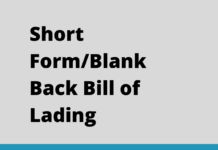According to the letter of credit rules a presentation consists of a transport document should be presented to the nominated bank within 21 days after the date of shipment, but not later than the expiry date of the letter of credit.
Bill of lading is a transport document covering the carriage of goods by sea.
If a set of documents, which consists of a bill of lading as a transport document, could not be presented to the nominated bank within 21 days after the date of shipment by the beneficiary, then late presentation discrepancy is emerged.
A bill of lading that is not presented within 21 days after shipment is called a Stale Bill of Lading.
In other words, stale bill of lading is a type of bill of lading which is presented to the nominated bank after the presentation period.
Stale Bill of Lading Example:
Let us try to understand the stale bill of lading term with an example.
An exporter in Malaysia signs a sales contract with an US importer for the sale of refined palm oil. The payment term is letter of credit. The importer have issued the letter of credit in favor of the exporter.
Letter of Credit Conditions:
- Latest Date of Shipment: 10.March.2019
- Expiry Date: 31.March.2019
- Presentation Period: 21 days after shipment but withing expiry date
Date of Shipment and Presentation Date:
The exporter completes the production and makes the shipment. Shipped on board date indicated on the bill of lading is 01.March.2019.
The exporter presents the documents to the nominated bank on 25.March.2019.
Conclusion:
The exporter could not complete the presentation within allowed time frame after shipment. Late presentation discrepancy condition has been fulfilled.
The shipping documents and also bill of lading is stale.
Related Articles:
- Stale Documents
- Shipping Documents
- Date of Shipment
- What Does Latest Date of Shipment and Expiry Date Mean in a Letter of Credit?
- How to Determine Date of Shipment on a Bill of Lading?
- How to Complete a Bill of Lading under a Letter of Credit Payment?


















